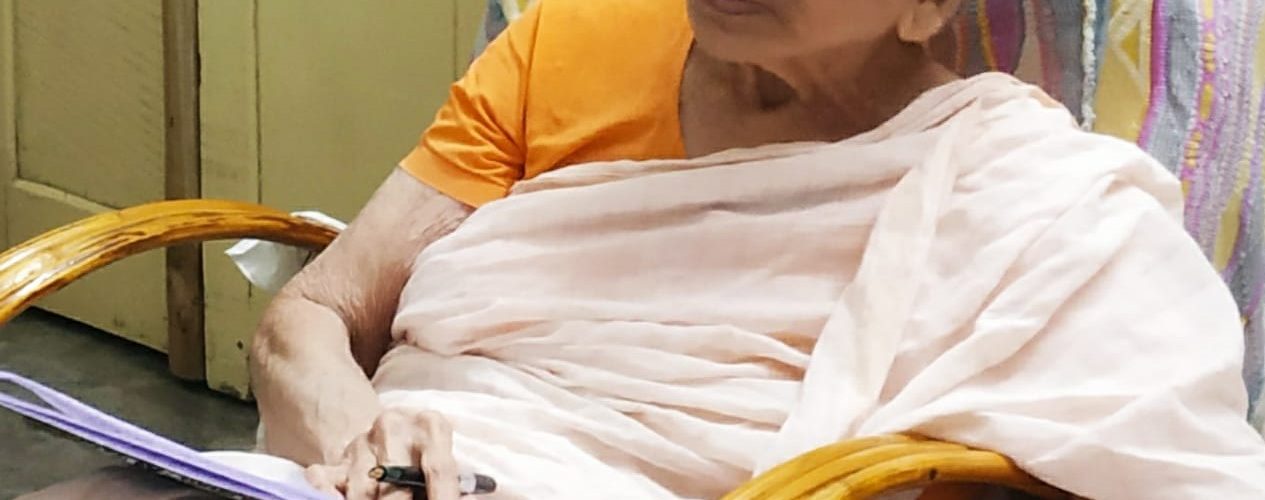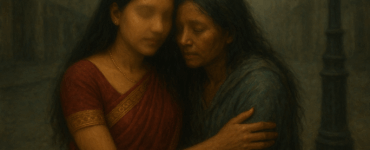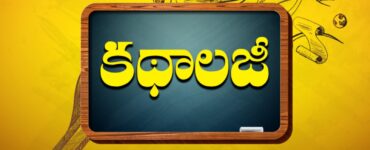Kala Enduku, Ranganayamma: What is Art For? Sweet Home Publications,76, Lake side Colony, Jubilee Hills Post, Hydearabad -500033; 4th Edition 2007; Pages 172
Ranganayakamma belongs to the era of modern fiction in Telugu literature. She was the pioneer for feminist writing in Andhra Pradesh, hers being the first strong female voice to be heard against the gender discriminations practiced in patriarchal societies in the Andhra region. In more than one sense, hers was a unique and powerful voice that can neither be repeated nor can it be ignored. Now 81 years old, she was born in 1939 in the West Godavari district of Andhra Pradesh. In the initial stages of her life, she wrote as Muppala Ranganayakamma, but left the surname later and wrote as Ranganayakamma.
Due to her uncompromising political and social beliefs, she was always surrounded by controversies. Her writings reflected her belief in Marxist philosophy. She wrote a very controversial Ramayana Visha Vriksham (The Poisonous Ramayana Tree) in response to Srimad Ramayana Kalpavriksham (The wish-fulfilling Ramayana Kalpavriksham) of Sri Viswanatha Satyanarayana, which won him the much renowned Jnanapeeth Award. Her interpretation of Ramayana through the Marxist political lens was probably the first of its kind. While it goes without saying that the richness of the text lent itself so easily, even to the diagnostically opposite angle of the society in Rama’s time. Rama as divine, gender discrimination in the patriarchal society of Ramayana and the belief that rishis were hypocritical in their assumptions of divine power- these were a few topics of her dismissive commentary on the centuries-old understanding of the text.
As expected, the first response to her text was rage, which gradually gave way to a more mature understanding of her extraordinary effort in bringing the basic cultural tenet of the text to scrutiny with a questioning mind. Ramayana as an important part of Indian mythological heritage forms into an unbroken chain through its oral history. It has always been seen as a diverse text–a part of a literary, religious, cultural and social fabric of our society. There are supposed to be more than 3000 Ramayanas and no two of them are alike. This Ramayana of Ranganayakamma will be one such milestone. Her other novels Like Janaki Vimukti, which was published as a serial was stopped midway as it had become very controversial, but later published as a complete novel in three volumes. Early novels like, Balipeetam, Pekamedalu, Kulina Godalu, Stree and Sweet Home were widely welcomed.
Balipeetam and Chaduvukunna Kamala were the two successful movies adapted from her novels. There can be any number of books written on her novels but we will be talking about the less controversial, but widely debated theme in the of world literature. Tolstoy wrote a detailed essay with this question “What is Art?” There are various arguments for and against the impact of art on society. What is art? Why is it produced? Who should it be addressed to? Should art be for art’s sake? Should it have a social purpose? Is art in any form, a form of self-articulation? Many questions and answers have come from different sources focussing on different facets of the fascinating term ‘art’.
The story of Kala Enduku isn’t very complicated. It opens with the dance performance of two talented sisters Padmini and Mohini. The writer, introducing the theme with this dance performance, had given the book an authoritative introduction to the dances of South India. The two girls were brought to the venue by their grandfather. Their performance was well received by the audience, and at every step, the dance was acclaimed by the spectators. In the same performance they get introduced to an artist named Gopal. Both of them were pleased at the compliments they receive from him. They come home and tell their grandfather all the details about the programme.
Balaramayya brought up these two girls after the death of his daughter, their mother. He wanted to train his daughter in Bharatanatyam. But his wife objected saying that this form of art does not command any respect in society, especially if the girls take to performing, it will attract unnecessary comments. Society is not kind to the girls who take to the stage and dance in public. He understood her anxiety and put her in music classes. She learnt to play the veena and gained good knowledge in music. She was passionate about her music, but her marriage had put a spoke in her continued education in the field. Her husband and mother-in-law objected to her musical career, as it was not considered a decent thing for girls from good families to participate in public presentations of any kind. Her veena was shifted to the store room. The superstitions thus, naturally extended to other wide-ranging aspects of life. When Kalabala (the daughter) was in labour, the midwife was unable to handle the complications. Her husband objected to a male doctor treating her. They could not take her to the hospital on time., where lady doctors were available. She died in child birth after giving birth to twin girls. Her husband regretted his decision later but it was too late. He was haunted by the guilt and died within a year. Balaramayya too, having lost his wife along with his daughter, brought up these two girls and made them learn dance and music. They were dedicated to these performing arts.
Gopal who gets introduced to them in one of their performances, came close to the family, particularly to Padmini. Mohini consistently tried to keep up their common goal of excelling in their art. Gopal gradually was attracted to Padmini. Their attachment grows particularly because Gopal was a painter and deeply attached to his art and understands the value of art. Padmini increasingly gets attached to him and allows him to paint her and she totally surrenders to his love. All of a sudden, he leaves for his village without giving her any contact address and she is left heart-broken. She tells Mohini and when she advises her sister to forget him and move on, believing only the art both of them had learnt with so much passion and commitment, she agrees half-heartedly. She could not tell her sister and was afraid to break her grandfather’s heart by revealing the truth of her pregnancy. She was so convinced by his manner of going away, his continued silence, and not responding to the letter she had written to him that she committed suicide. After her death Gopal comes back and tells Mohini about his serious illness and his sister’s death and a series of events that prevented him from coming for her. He was shattered when he heard that she died due to his ‘indifference’. He was also deeply resented that she did not trust him and he leaves with a broken heart. Mohini too feels sorry that she did not believe Gopal and provoked her sister indirectly to take the extreme step.
Mohini continues her dance and becomes an international figure and meets a man named Sudhakar in a conference in Germany. Again, when he visits India, he comes to her home and they become friends gradually. She gets to know that he is a poet but was very shy of bringing them into public domain and had deep understanding appreciation for her art. He worshipped her for her talent. When he proposes marriage, she agrees as she does not doubt that he would have any problem to her dance performances after marriage. Ten days after marriage he told her, her dance should only be for him and she should not dance on stage in public. She was shattered but Mohini refused to cling to him and her relationship with him and goes back to her home. She continued to love him but could not compromise to leave her dance for her love. Story comes to square one and how he finally Sudhakar decides to come back into her life and how Gopal makes a re-entry to help her to achieve a fulfilment of her dream are parts of the story one needs to read how delicately the narrative moves a towards a positive conclusion is something readers would enjoy at first reading. This review does not intend to spoil the pleasure.
Balaramayya, the patriarch lives through three generations. His taste for art in any form was central to the narrative. The story is set in the early days of independence. His daughter Kalabala gets married to a person who is rooted in the patriarchal traditions and with ideas of what girls should do and what they should not. He gets these ideas from his mother. And from day one of their marriage, he wanted to sail clear of troubles and warns his wife to obey his mother unconditionally. She was not allowed to touch her veena even for playing for her own pleasure. Her veena is shifted to the store room. In Indian household girls were taught music to felicitate easy marriage in those days. Once married, they have no need for the qualifications, achievements or the talents as they are expected to look after the family, cook wash and clean. When she comes home for delivery, the husband decides when her delivery gets into complications, not to take the help of male gynaecologist and the doctor had to go back and the lady doctor could not come on time and Kalabala dies. Today one could say she was murdered by the ignorance and rigidity of her husband. He dies soon after, regretting his decision not to take his wife to a male doctor. The girls become orphans and Balaramayya takes them under his wings.
But Balaramayya silently accepts the fate and brings up the twins that his daughter leaves behind. His love and passion for art become so convincing when he puts both his grand-daughters into dance classes. His wife protested when he sent his daughter to dance so he chose to send her to music as she advised him any time it is easier to pursue music rather than dance after marriage. Her advice did not work out for his daughter.
The girls Padmini and Mohini competitively learn dance and Mohini became adept in music too following her mother’s foot-steps. The narrative opens with their dance performance. Both of them for different reasons suffer the same fate as their mother, Kalabala. But in the second generation the reason was not patriarchal mindset. Padmini suffers purely because of miscommunication and misunderstanding. The art she had learnt had not given her that solace and confidence in life that would have otherwise saved her. Her imaginary fear that her grandfather would be upset or that the society would not forgive her created a void in her mind. Mohini was the most sensible of all in the narrative. She encourages Sudhakar to write and publish his work. She convinces him art serves its purpose best when it is received by the audience/readers.
If it stays with the artist how would it serve its purpose? Just as Padmini convinces Gopal that his paintings should focus on social aspects and an artist with a social consciousness would be an asset to the society and self, Mohini also turns Sudhakar’s attention to the larger purpose of art than keeping it to himself. Creativity flourishes only under receptivity. He has within himself the trait to appreciate Mohini’s art and he adored her and had fallen in love with her only because of her art. But because of his selfishness and insecurity, definitely not disrespect for her as an artist, he puts the condition that she should dance only for him. He tried to own her along with her art, which disturbed her and disappointed her. The narrative concludes on a positive note when he comes back to her with a change of heart. Gopal, Balaramayya, Mohini and the spirit of Padmini rejoice in the perspectives of art, its various facets and the fact that ultimate bliss that art can give comes only when one is open minded, generous and tolerant of all forms of art.
*









I haven’t read it fully yet.
Found two mistakes.
1. Ramayana vishavruksham is not written as a reply to Ramayana Kalpavruksham. If you read either book in detail, you wouldn’t say that.
2. Chaduvukunna Kamala didn’t get produced as. Movie. It never happened.
Will read the rest later.
Prasad